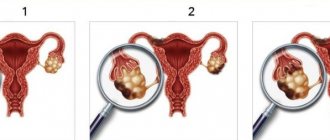The ovaries are a paired organ of the female reproductive system, responsible for the production of sex hormones and the maturation of eggs. Like any other organ, the ovaries are susceptible to the development of tumors of a benign and malignant nature. In the treatment of benign tumors, the neoplasm does not grow; it is removed surgically and the woman is forever freed from the pathology. In the case of a malignant tumor, cancer cells grow in the body, affecting other organs.
The Yusupov Hospital diagnoses and treats ovarian cancer. Using high-tech equipment, they conduct research on hormone levels and the presence of tumor markers, ultrasound of the pelvic organs, MRI, biopsy, and laparoscopy.
A timely examination can save your life and health.
Ovarian cancer: causes
The exact causes of cancer development have not been identified to date. There are a number of factors that can provoke the development of cancerous tumors. Among them:
- genetic factor: genes are identified whose presence increases the risk of developing the disease. Modern developments in medicine make it possible to conduct an analysis to identify malfunctions (mutations) in these genes in order to assess the likelihood of developing ovarian cancer;
- age factor: after 45 years, the risk of developing pathology increases;
- hormonal imbalances: it is known that girls who have given birth have a much lower risk of developing the disease than childless girls. Pregnancy increases a woman’s protective function in terms of the development of cancer of the reproductive system. The risk of developing a tumor increases with long-term use of drugs that stimulate ovulation. On the contrary, combined contraceptives reduce the risk of tumor growth;
- inflammatory processes in the organs of the genitourinary system of a chronic nature;
- unfavorable environmental background;
- venereal diseases;
- irregular sex life.
These factors do not mean that a woman will eventually develop ovarian cancer. All these phenomena only increase the risk of developing pathology and nothing more. The more factors that affect the female body, the greater the risks.
Survival after surgery
For cases with more advanced stages of the disease (stages II-IV), most oncologists are of the opinion that the tumor should be removed as much as possible during primary surgery. A good palliative effect is achieved even if the tumor size can be reduced surgically. However, few results indicate that the life expectancy of patients increases if all or almost all of the tumor is not removed. Many operable tumors are characterized by a low degree of malignancy, which in itself is the basis for a favorable prognosis.
Nevertheless, the maximum size of the tumor area remaining after resection is a good guide for the subsequent administration of a course of chemotherapy and further prognosis. When calculating survival after regression surgery for ovarian cancer, it turns out that the greatest contribution is made by such parameters as the histological characteristics of the tumor and the maximum size of its area remaining after surgery. If, as a result of the operation, the size of the tumor has not decreased to 1.6 cm (or less) in diameter, then such an operation is ineffective.
If after surgery the patient has palpable residual lumps, then prescribing a course of chemotherapy or radiation therapy is unlikely to be effective.
Therefore, at least some of them may require repeat surgery, which should be performed by an experienced surgeon. Nowadays, complex operations such as removal of the pelvic organs, removal of the omentum, resection of the colon, and complete removal of the parietal pelvic peritoneum have become more common.
How does ovarian cancer manifest: symptoms, stages
The first signs and symptoms of ovarian cancer appear, as a rule, already in the later stages of development of the pathology. At the very beginning, the woman is not even aware of the pathological process occurring in her body at a time when cancer cells are rapidly attacking the ovaries.
Signs of ovarian cancer in the early stages are often “masked” as symptoms of pathologies of the bladder and digestive tract. As the tumor develops, a woman begins to experience pain due to ovarian cancer in the abdomen, back, and pelvis. As a rule, patients experience a frequent urge to urinate, caused by the pressure of the growing tumor on the bladder.
Signs of ovarian cancer in women (the first symptoms) often appear as fluid accumulation in the abdominal cavity. In this case, the stomach visually increases noticeably. Pain syndrome is often observed during sexual intercourse. Ovarian cancer in women is mainly manifested by general weakness, fatigue, loss of appetite, and nausea.
The disease is classified into four stages:
- first stage: pathology develops only on the ovary. There may be an accumulation of fluid in the abdominal cavity;
- second stage: signs of the disease become more pronounced, the tumor begins to gradually grow beyond the ovary;
- the third stage is ovarian cancer with metastases to adjacent organs;
- fourth stage: metastases to distant organs are detected.
The disease is classified as follows:
- primary ovarian cancer. Most cases occur in women under 35 years of age. Cancer cells affect the organ on both sides in the form of lumpy, dense formations;
- secondary ovarian cancer. Presents in the form of a cyst filled with mucus or fluid. Typically, cystic formations are benign, but sometimes develop into cancer;
- metastatic ovarian cancer. We are talking about those cases when cancer cells enter the ovaries from other organs. In practice, the spread of malignant cells from stomach tumors is widely known. Infection occurs through lymph nodes or blood.
Pathogenesis
Speaking about the pathogenesis of ovarian cancer, most experts agree that a benign tumor initially develops, which gradually loses differentiation. First, a benign tumor appears, later a borderline tumor, and then a malignant tumor. Canceled that tumors come in two types. Formations of the first type grow slowly, they are delimited from the tissues by a capsule, and they are characterized by a good prognosis. This type includes poorly differentiated mucinous, serous, clear cell tumors, as well as Brenner tumors.
Formations of the second type are highly aggressive cancer, the precursors of which have not been established. This type also includes well-differentiated serous carcinoma , mixed mesodermal tumor , and undifferentiated carcinomas . Such formations are genetically unstable.
In 90% of cases, ovarian cancer develops from a single pathological cell.
Ovarian cancer: diagnosis
The types of diagnostics in this case are chosen by the doctor. If any kind of discomfort occurs, a woman should immediately seek advice from an oncologist at the Yusupov Hospital. Unfortunately, symptoms of ovarian cancer appear already at an advanced stage. The specialist, if indicated, will refer the patient for analysis to detect ovarian cancer. The methods for diagnosing pathology are:
- general, specific and biochemical blood tests. Studies are being conducted to check hormone levels, as well as the presence of tumor markers;
- Ultrasound of the pelvic organs. This method allows you to identify the tumor itself, its size and location;
- MRI and CT: methods allow you to determine the location of the tumor and its size with high accuracy;
- biopsy: a small tissue sample is taken from the patient for subsequent histological examination to detect cancer cells;
The oncologist at the Yusupov Hospital may prescribe other types of examinations and tests if necessary.
Classification
According to international histological qualifications, the following types of carcinomas are distinguished:
- serous - (carcinomas of this type are distinguished as low and high grade);
- mucinous;
- endometrioid;
- clear cell;
- serous-mucinous;
- Brenner's malignant tumor;
- undifferentiated;
- mixed epithelial.
There are several stages of the disease according to the degree of its development:
- Stage I – only the ovaries are affected.
- IA - only one ovary is affected, ascites .
- IB – both ovaries are affected, there is no ascites.
- IC – a tumor appears on the surface of an ovary or two ovaries, ascites.
- Stage II – the disease spreads throughout the pelvis.
- IIA – the uterus or fallopian tubes are affected.
- IIB – other tissues of the pelvic organs are affected.
- IIC – a tumor develops on the surface of an ovary or two ovaries, ascites.
- Stage III – peritoneal carcinomatosis develops, metastases appear in the liver and other organs of the peritoneum, and the inguinal lymph nodes are affected.
- IIIA - the process spreads within the pelvis, seeding of the peritoneum occurs.
- IIIB – metastases appear, the diameter of which is up to 2 cm.
- IIIC - metastases appear, the diameter of which is more than 2 cm, the retroperitoneal and inguinal nodes are involved.
- IV
– distant metastases appear.
Germ cell tumors are also identified, some varieties of which can be malignant. Germinogenic formations are associated with malformations of the primary germ cell. This type of tumor includes teratoma (tetrablastoma) - a tumor that can be either benign or malignant. This is an embryonic cell tumor that is formed from layers of endo-exo- and mesoderm. It appears even before birth, and can appear at any age. Despite the fact that different types of such tumors are identified (fetal neck teratoma, sacrococcygeal teratoma, etc.), most often in women it appears in the ovaries. Immature teratoma can be malignant and metastasize to other organs.
Ovarian cancer: treatment
Cancer of the left ovary, the symptoms of which do not appear in the early stages (as with cancer of the right ovary), responds well to surgical treatment. In most cases, the uterus is extirpated along with the appendages. In women of reproductive age, attempts are made to preserve childbearing function.
Treatment for ovarian cancer is always complex. Before surgery, the patient may be prescribed chemotherapy drugs to help the tumor fade. Chemotherapy is also prescribed after surgery to destroy any remaining cancer cells in the body.
Radiation therapy in the treatment of ovarian cancer is prescribed quite rarely, since it is ineffective for this type of disease. Irradiation is carried out only as palliative treatment to improve the patient’s quality of life and prolong it.
The effectiveness of treatment directly depends on the stage of the disease. With timely detection of pathology, small tumor sizes and the absence of metastases, the chances of a complete recovery in patients are 90%.
Diet
Diet for ovarian cancer
- Efficacy: no data
- Duration: until recovery/lifelong
- Cost of food: 3200-4300 rubles per week
For ovarian cancer, nutrition should be rational and as natural as possible. It is important to practice these basic nutritional principles:
- Products must be natural and healthy. Canned food, as well as food with stabilizers and preservatives, should be kept to a minimum.
- The menu should contain as many vegetables, fruits, berries, and nuts as possible.
- The diet should be formulated so that it contains all the vitamins and minerals necessary for the body.
- The menu should include those foods that help cleanse the blood of toxins and stimulate the functions of the immune system. These are sea fish, grains, beets, broccoli, cabbage, nuts, etc.
- You need to drink about 2 liters of water per day.
It is recommended to include the following products in the diet:
- Seeds and nuts.
- Fresh vegetables, herbs, berries, fruits.
- Fish oil, seafood, sea fish.
- Various vegetable oils.
- Eggs.
- Lean meats.
- Bran, muesli, cereal.
- Wholemeal bread.
- Dairy products.
- Honey.
- Fresh juices, berry fruit drinks.
It is very important to eat well after chemotherapy to avoid deficiencies of minerals and vitamins.
At the same time, the following products should be minimized:
- Salt.
- Smoked meats, marinades, sauces.
- Semi-finished products.
- Soda.
- Coffee, strong tea.
- Sugar and weaknesses.
- Baking, white bread.
- Saturated fats.
- Fat meat.
Consequences and complications
Ovarian cancer is a dangerous disease that can lead to the development of metastases , and in the absence of adequate and timely treatment, death.
anemia and leukopenia may develop . Kidney disease is also likely to develop. Chemotherapy increases the risk of toxic hepatitis .
After therapy, there is also a risk of re-development of the tumor, so constant preventive monitoring is very important.










